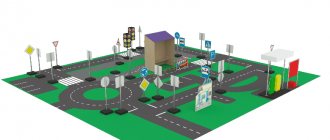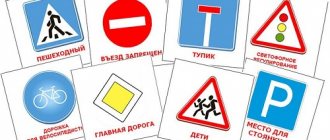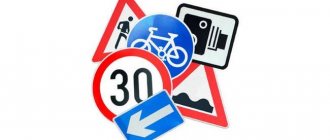Young children have selective attention, lack correct assessment of distance and an unformed sense of self-preservation. These features of the children's psyche are relatively safe at home and on the children's playground, but turn children into the most vulnerable road users. According to statistics, children, the most vulnerable road users, become victims in 3-5% of road accidents, and most often if they find themselves on the roadway unaccompanied by adults.
That is why the task of parents, kindergarten teachers and school teachers is full control of the child’s safety and the utmost seriousness in teaching children the rules of the road and behavior on the road.
Safety rules for children on the road
Children do not need to be forced to learn all the traffic rules, but they should be taught basic safety rules that will preserve their life and health in critical traffic situations. The simplest and most important safety rules for children to remember include the following:
- You should only walk on sidewalks.
- Without adult accompaniment, it is better not to go to the side of the road and not to try to run out onto the road or cross it in places where there is no pedestrian crossing.
- When crossing unregulated pedestrian crossings, you should carefully look to the right, then to the left, be sure to listen and make sure that there is no car dangerously close, and only then cross.
- At controlled pedestrian crossings, you must comply with the requirements of traffic lights (red - stop immediately, green - you can move, but after the cars have completely stopped).
- Do not attempt to cross the road at intersections or turns that are not equipped with pedestrian crossings, where visibility for drivers is limited.
- You must not run, play, hide behind cars or cling to vehicles on the roadway. You should stay away from cars and in yards.
- Standing or stopped cars should only be passed from behind. It is better not to bypass public transport - it is dangerous both in front and behind.
Older children who independently ride bicycles, scooters and roller skates must wear a special protective helmet and move only in safe pedestrian and bicycle zones - on sidewalks, bike paths, in a stadium or in a park. The bicycle must be in good working order, especially the brakes, and equipped with reflective elements (in the evening).
When traveling in a car, children must sit in the back seats, be sure to buckle up and not lean out of the windows. You can disembark only at a planned location (not on the roadway), after the car has completely stopped and under the supervision of an adult.
Two more important rules that must be conveyed to the child: firstly, you should behave calmly on the road and not make sudden movements, and secondly, try to be visible so that drivers can control the traffic situation and react adequately.
Perception of the road in children of different ages
Children 3-5 years old can distinguish a car in motion from a stationary one. And yet, they are convinced that the vehicle can stop instantly. Small children are not able to truly assess the approximate speed of a car or the distance at which it is located. And the child has no idea about the braking distance. In the subconscious of children, cars are controlled toys that can easily brake if desired.
At 5-6 years old, the senses develop better: lateral vision is 2/3 closer to what an adult can see. But the child still cannot correctly distribute his attention and distinguish between the significant and the unimportant.
The average age when children confidently know where the right side is and where the left is is 7 years.
At the age of 9, the child has the skills to move on the roadway: masters a bicycle, knows how to instantly react to a sound, and also finds a relationship with the size of an object and its distance (the further away the car, the smaller it is).
Children have selective attention.
One of the features of child psychology is selective attention. For this reason, children are not able to concentrate on more than two objects at the same time. From all the diversity of the surrounding world, the child grabs what is most curious to him now, to which he directs 100% of his attention, for example, a ball that jumped out onto the road.
If my eyes don’t see danger, then it doesn’t exist.
Only by the age of ten does the child’s nervous system complete its development.
Noticing the danger in front of them, the kids freeze in horror, closing their eyes tightly. A stereotype operates in a child’s subconscious: “since I don’t see danger, it means it doesn’t exist, and everything will be fine with me.”
How to teach road safety rules to young children?
As you can see, there are not many road safety rules for children, and they are not difficult to remember. However, you should always remember that a child of 5 years old does not have clear lateral vision and cannot always distinguish a stationary car from a moving one, and is able to more or less accurately determine the distance to a car on the road at 7-9 years old.
That is, the adequacy of perception of the situation, the ability to simultaneously control several objects and analytically make the right decisions do not work in young children. Therefore, they must memorize traffic rules not on the basis of experience, but “artificially”. And here it is very important to approach learning correctly so that children quickly and efficiently remember information.
- Of course, the best way for children to learn traffic rules is to learn in the family from an early age. First of all, the example of parents who themselves follow safety rules and at the same time explain their actions to their child is important. With repeated, visual and systematic repetition of the rules followed by questioning, parents will be able to quickly determine how much the child understood and remembered the information received. At the same time, attentiveness, discipline, memory and a sense of self-preservation are trained. The ideal form of presenting information is an unobtrusive explanation and game, in which the child remembers important data quickly and confidently.
- At the same time, in the same playful form, children should be taught traffic rules in kindergarten - there is group training, using sets of road signs, and this is also effective: children role-play road situations and learn, quickly adopting knowledge and rules of behavior from each other. In the process, you can use bright books, coloring books, albums and cards on the topic, drawing and learning poetry.
- At school, growing children can consolidate their knowledge at a more serious theoretical and analytical level, especially if real traffic police inspectors are present at traffic lessons. Special entertaining crossword puzzles for children and practical exercises on equipped areas with markings and road signs effectively train skills.
The general process of teaching traffic rules in children's and school institutions should be led by the local traffic police, which prepares training plans for parents, educators and teachers, and also directly participates in the educational process in accordance with existing road accident prevention plans.
With the right approach to the process of learning traffic rules, children by the age of 10-12 are fluent in basic safety rules, are well oriented as pedestrians in a road situation and are able to apply their knowledge in practice. However, it is wrong to stop learning here: periodic repetition of the studied material is necessary until the age of 16, when a person begins to use the information received analytically.
On the railway
The railway tracks deserve special attention. It is important to explain to your child that the railway is not a place for games, and that you should stay away from trains.
Crossing paths can be done where traffic lights and specially designed pedestrian “paths” are installed. When there are none nearby, make sure there are no trains 500 meters in either direction.
It is prohibited to cross tracks where automatic switches are installed.
Parents must lead their children by holding their hands tightly. If you are crossing paths with a stroller, it is important to keep in mind that the child is somewhat further away from you, so you must carefully assess the situation ahead.
Use extreme caution in adverse weather conditions and poor visibility. Show yourself some care.
Road safety rules for accompanying adults
The safety of children on the road depends, first of all, on the adults who accompany them. Therefore, it is also very important for parents, kindergarten teachers and teachers to know traffic rules well and strictly follow them.
Pedestrians with children should remember that:
- You can only move on sidewalks and pedestrian paths;
- the child should be carried in arms or led by the hand when crossing roads and streets;
- You can cross the road only at pedestrian crossings (if there are none, on the side of the road towards oncoming traffic).
In a car: the child must be securely fastened (or transported in a car seat), must not be left alone in the cabin, and the doors must be locked. Children should not be allowed to hang out of windows, and when driving, adults should behave as carefully and carefully as possible to eliminate any risk of an accident.
Drivers should remember that in the immediate vicinity of schools, kindergartens, playgrounds and courtyards of multi-apartment high-rise buildings, they should drive slowly and carefully, and the most dangerous period of the year is the school year (especially at night).
In high school
Middle and high school students need a different approach. They also love online interactives and quests, but the presentation can and should be more complicated.
You can talk to teenagers for longer, covering a larger volume of knowledge at a time. Systemic work is also carried out by employees of the State Traffic Inspectorate - they visit schools, conduct lectures, trainings, and simply talk with children. An important role is played by holding “safety minutes” at the end of the school day.
Photo: TASS/Anton Vergun
In addition, older schoolchildren can be involved in working with younger ones - for this there are units of young traffic inspectors (YIT), which appeared in Soviet times.
“Safety is mainly on paper”: what is the cause of accidents with buses
Passenger transport accidents have increased despite stricter safety measures
— Children participate in creative competitions, drive two-wheelers, learn traffic rules, etc. This is a huge movement of interests, which the State Traffic Inspectorate is gradually reforming today so that it also becomes the basis for subsequent education,” noted the president of the expert Natalya Agre.
Other situations for safe behavior
While at the station, you should remember that you cannot go beyond the security line at the edge of the passenger platform.
Note! You need to take off your headphones or hood so that nothing prevents you from noticing the approaching train.
It is life-threatening to play on platforms, cross tracks in the wrong places, and climb under stationary trains.
Child behavior on the bus
Child passenger in a private car
While in the car, the child must be seated in a car seat, fastened with a seat belt. It is strictly forbidden to distract the driver, lean out of the window, or throw objects through it, as this can lead to an emergency situation and injuries.
Children. Road. Safety
Sergei Sobyanin
September 24 at 09:00
Share
no comments yet
From September 20, Moscow and other regions of the country are hosting the All-Russian Road Safety Week.
. This year, special attention is paid to reducing road injuries in children and adolescents.
Over the past 10 years, we have achieved a radical reduction in child mortality and injuries on Moscow roads.
The number of children killed in road accidents decreased by 4 times - from 12 people in 2010 to 3 people in 2021.
The number of victims decreased by 40% - from 1043 to 634 people.
In terms of road injuries, the capital is already the safest region of the country. But still this is not the limit of the possible.
I’ll tell you what we are doing to further reduce the number of accidents involving children and teenagers.
First of all, we continue to restore order on the roads.
An intelligent transport system provides automated control of traffic flows.
And photo-video cameras recording traffic violations and patrolling by traffic police officers are the most important tools for preventing dangerous driving.
Step by step we are putting things in order in the taxi business. The recently introduced Taxi Operations Analytics information system allows you to control the work and rest schedule of taxi drivers, preventing overtime and excessive fatigue while driving.
And, what is very important, over the past 10 years we have built 271 off-street pedestrian crossings in Moscow and organized more than 2.5 thousand new ground crossings. Several thousand new traffic lights were installed.
Every year, together with the traffic police, we analyze pedestrian routes
, which are actively used by children and adolescents. Based on the results, recommendations are developed and implemented on how to make them safer: install a speed bump or traffic island, reduce the permitted speed, or organize a new pedestrian crossing.
In addition, in recent years, contrasting lighting of crossings has been installed near educational institutions, which helps drivers see pedestrians in a timely manner even on dark winter days.
Every year, on the eve of September 1, city services and the traffic police check the condition of the road infrastructure at each educational institution. By the end of 2021, new guidelines will be prepared for organizing safe zones within a radius of 200 m from schools. Their implementation will help to radically reduce the likelihood of road incidents.
And, of course, we continue to teach and explain the rules of safe behavior on the roads.
Recent studies have shown ( and you see it yourself every day
) that 72% of high school students use a smartphone on the way to school: listening to music or surfing the Internet. Of course, it’s more fun to go this way, but, unfortunately, it is fraught with great danger on the road. It is necessary, without getting tired, to explain to children that under no circumstances should they use a smartphone when crossing the street.
By the end of the year we plan to develop a unified educational program on safe behavior on the roads, which will be used in all Moscow schools.
As for the youngest, it all depends on us, adults. By waiting for a green traffic light, you not only protect yourself. You save the life of a child who stands next to you and takes an example from you.
Tags
- Safety
- Children
- Roads
3 more tags
hide
Share with your friends!
A ride on the bicycle
Large cities are increasingly filled with specialized paths for lovers of two-wheeled transport.
Cyclists, as well as moped drivers, are required to move in a single file only on the far right side of the road. Driving on the side of the road is permissible only if you do not interfere with pedestrians. And if you are driving for the first time or do not know the rules, under no circumstances drive onto the roadway.
Important! When crossing the road, get off your bike. Driving along the zebra crossing is prohibited.
Restrictions for drivers of a two-wheeled friend:
- if there is a bicycle path, move along the roadway;
- transport cargo that protrudes beyond the dimensions by more than 0.5 meters, or interfere with the proper control of transport;
- transportation of passengers, except children under 7 years old on a special seat;
- Driving without holding the steering wheel is prohibited;
- turn left or make a U-turn on multi-lane roads;
- restrictions provided for by individual painted prohibition signs.
Bicycles should be equipped with working brakes and a sound signal. When riding a bicycle at night, be sure to have lights: white in front and red in the back; Reflective elements of orange and red colors should also be located on the sides.
Important! High speed increases the likelihood of an accident, and therefore serious consequences. The speed of the bike is selected taking into account actual road and weather conditions, ensuring the safety of all road users.






